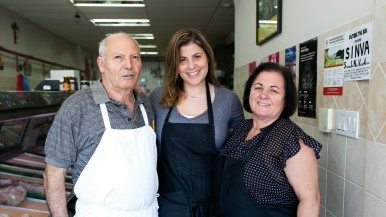Your salad says it’s local, organic and sustainable—but is it?
Toronto’s proliferating salad bars all seem to market their goods by trumpeting the ethical value of their ingredients. We checked their claims against their sources

“We try to use local and organic whenever possible.” Everywhere I go, I hear that claim. What does it even mean? A hot dog vendor could make that statement and not be lying one bit. It’s like promising your partner that you’ll be faithful to them “whenever possible.”
A recent investigative report in the Tampa Bay Times uncovered rampant fraud in that area’s food scene—restaurants making entirely untrue claims about the provenance of all their “local” and “organic” ingredients. Naturally, those who read the report were suspicious of claims in their own cities. But Toronto is not Florida. Other than the anomalous story of Azure passing off Quaker Harvest Crunch as organic granola and corn syrup as maple syrup, we are not a population known for brazen mistruths. Our restaurateurs are far more likely to use vague language on menus, misleading diners with feel-good buzzwords, than bald-faced lies.
You can get all kinds of produce in Ontario, all year round. It may have to come from a greenhouse in the winter. It will definitely be more expensive. And the customer will absolutely have to pay more. But it’s possible. Restaurants that are truly committed can seek accreditation through FeastON, a provincial organization that conducts audits to determine how much of an establishment’s products come from Ontario. However, if customers have never heard of FeastON, that designation has no value—certainly not as much value as the words “local” and “organic,” even if those are meaningless. Another way a restaurant can be more sustainable is to change its menu every season, to truly reflect what’s available locally. Restaurateurs who say it’s impossible to accommodate their patrons in the winter months without ordering all of their produce from California probably haven’t tried very hard.
“Anybody that squawks about finding ingredients in winter is using a single-source distributor,” says Brad Long, chef and owner of Café Belong at the Evergreen Brick Works. “It’s a dead giveaway, because the distributors’ raison d’être is to try to keep prices the same all year long.” Between 1998 and 2008, Long was the executive chef of the Air Canada Centre, in charge of multiple food service operations that served 19,000 customers a day. Now, as the owner of a 203-seat restaurant, Long doesn’t have to make the concessions he did at the stadium: Café Belong’s site says, “Everything we do is local with our lowest standard of procurement being organic.” It’s the most sweeping sourcing claim of any restaurant in this city.
“Everything that’s grown locally is cheaper, so there are times when prices can go down, too,” says Long. Smaller, independent restaurants can change their menu with the seasons but it’s a challenge that most chains aren’t willing to meet. Training staff to adapt to changing menus and the unpredictability of ingredients (big carrots one week, small ones the next) is only one obstacle. A larger hurdle is training customers to understand why they can’t have asparagus in December. Diners don’t want to read a book on farming or fishing in order to buy lunch with a clear conscience. They want simple identifiers of value or virtue—“local, organic, sustainable”—words that say, in just a few syllables, “this thing is okay to eat.” They also want their food to be cheap, and this is the tricky part.
Restaurants are businesses, not NGOs. But if maximizing profits is the priority, they can’t make any sincere claims to local sustainability. No one’s suggesting they should lose money in the name of saving the planet. In other words, you can have a truly local, organic salad if you want it—but it’s going to cost you.
We spoke with some of Toronto’s most popular salad purveyors to find out whether their vegetables are as virtuous as they claim to be.
Urban Herbivore
Locations: Three
Website claims: “We try our best to offer local and organic ingredients. Our produce is hand selected from farmers. Salad bar items may change without notice due to seasonal availability.”
Jessica Watchorn, manager
Where is your lettuce from, currently?
“Spring mix, baby spinach and spinach from California; arugula from Florida; kale, cabbage and red leaf lettuce from Canada. If it’s in season in Ontario, it will be cheaper and better. We buy in season when we can but obviously for most of the year, all of the food is coming from California, Florida or Mexico. It’s a salad bar—if we were going to have all local food, we’d have to close the restaurant.”
What Ontario produce do you use?
“Alfafa, tomatoes, onions, cucumbers, ginger and potatoes.”
How do you manage the fluctuating price of produce throughout the year?
“We can’t pass fluctuating prices on to the customer so we have to ride it out and absorb some of the cost.”
The Baro
Locations: One, with plans to expand
Website claims: “We aspire to use local products whenever possible, but some products just aren’t available from local sources in the depth of winter. During that time, we look to source as much as possible from our cousins to the south.”
John Gaganiaras, co-owner
Where is your lettuce from, currently?
“Romaine is something you can source locally though hydroponic means or the area’s greenhouses. Not much is found locally though, so we source ours from California. And the spring mix. And the baby spinach.
What Ontario produce do you use?
“Red peppers, cucumbers, onions, fingerling potatoes and beets. It changes throughout the year.”
How do you manage the fluctuating price of produce throughout the year?
“We try to make the money in the summer months to be able to pay for the higher food costs in the winter.”
IQ Food Co.
Locations: Five
Website claims: “we create restaurant spaces that celebrate health and wellness and show an appreciation for thoughtful design. Vibrant and balanced food is the centrepiece, but it’s the details we find beautiful. We’re a Toronto-based company with respect for the uniqueness of our roots, excited about making a dent on a global scale.”
Alan Bekerman, founder
Where is your lettuce from, currently?
“It changes all year round, but at the moment we’re sourcing organic baby arugula from The New Farm (Creemore, ON), and organic baby kale, romaine and baby spinach from Salinas, California. The harvest for Ontario kale has just begun and in the coming weeks we’ll be moving to organic baby kale from either Pfenning’s (New Hamburg, ON) or Zephyr Organics (Zephyr, ON).”
What Ontario produce do you use?
“We’re either currently using or have orders coming in for red beets, red cabbage, red radishes, cucumbers, watermelon radish, celery root, cilantro, parsley, organic sunflower sprouts, organic microgreens, orange bell peppers, strawberries and organic baby arugula. Some of our Ontario suppliers include the Den Boer Family Farm (Otterville), Jang Min Farms (Bradford), Slegers Greenhouse (Strathroy), Double Diamond Farms (Leamington), the Ippolito Group (Burlington), Greenbelt Microgreens (Strathroy) and St. David’s Hydroponics (Niagara-on-the-Lake).”
How do you manage the fluctuating price of produce throughout the year?
“We’re constantly editing because our brand revolves around the concept of a seasonal kitchen. We’ll always have our guests’ favourite dishes listed, but a meaningful portion of our menu changes every quarter. That means every season, at least three to four new dishes are added. We use our seasonal launches to assess where we’re at cost- and price-wise and adjust accordingly. We make a point to let our guests know about menu changes well in advance through signage and custom-printed cards. We also encourage our team to talk to our guests about it.”
Kupfert & Kim
Locations: Six
Website claims: “We make delicious, sustainable and minimally processed fare. We source local as much as possible, and ensure that any produce on the Environmental Working Group (EWG)’s Dirty Dozen list is organic at our shops.”
Mark Kupfert, co-owner
Where is your lettuce from, currently?
“We are currently ordering organic mesclun from Salinas, California. With summer firmly here, we’re using Ontario outdoor organic green and red leaf lettuce. Our organic kale is either from Pfenning’s (New Hamburg, ON) or Cal-Organic (California) depending on price and season. Our shoots and sprouts are from Living Earth Farm (Toronto).”
What Ontario produce do you use?
“Beets, blueberries, bok choy, cabbage (purple, white and napa), carrots, cauliflower, cucumbers, green onions, leeks, button mushroom, parsley, tomatoes, red and watermelon radishes, mung bean sprouts, pea shoots, strawberries and zucchini.”
How do you manage the fluctuating price of produce throughout the year?
“We make our own house sauerkraut and kimchee from Ontario cabbage. For winter, our produce cost is typically 20 to 25 per cent higher, but some stuff can really jump—organic kale can go as high as $55 a case. We average out the yearly price for produce, accounting for fluctuation assumptions and then price accordingly. Sometimes there are big surprises, though—this past January the price of cauliflower went from $30 a case to $80 a case. It’s a key ingredient in one of our most popular dishes. In the end we kept retailing the dish at its normal price and waited things out. By March, the price was back to normal.”
Fresh
Locations: Four
Website claims: “As a busy restaurant and juice bar we’re always searching for new ways to reduce our impact on the Earth and its resources. We strive daily to make a difference in the best possible way. We also use organic produce whenever it is available and affordable.”
Where is your lettuce from, currently?
Fresh did not respond to multiple interview requests.










